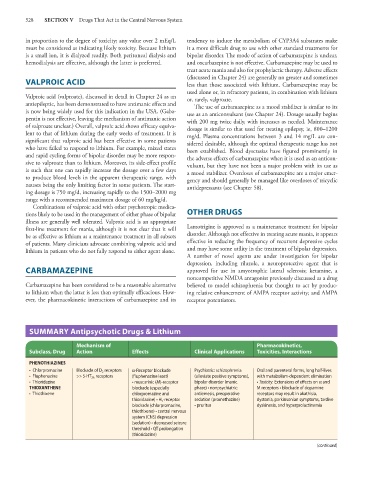Page 542 - Basic _ Clinical Pharmacology ( PDFDrive )
P. 542
528 SECTION V Drugs That Act in the Central Nervous System
in proportion to the degree of toxicity; any value over 2 mEq/L tendency to induce the metabolism of CYP3A4 substrates make
must be considered as indicating likely toxicity. Because lithium it a more difficult drug to use with other standard treatments for
is a small ion, it is dialyzed readily. Both peritoneal dialysis and bipolar disorder. The mode of action of carbamazepine is unclear,
hemodialysis are effective, although the latter is preferred. and oxcarbazepine is not effective. Carbamazepine may be used to
treat acute mania and also for prophylactic therapy. Adverse effects
(discussed in Chapter 24) are generally no greater and sometimes
VALPROIC ACID less than those associated with lithium. Carbamazepine may be
used alone or, in refractory patients, in combination with lithium
Valproic acid (valproate), discussed in detail in Chapter 24 as an or, rarely, valproate.
antiepileptic, has been demonstrated to have antimanic effects and The use of carbamazepine as a mood stabilizer is similar to its
is now being widely used for this indication in the USA. (Gaba- use as an anticonvulsant (see Chapter 24). Dosage usually begins
pentin is not effective, leaving the mechanism of antimanic action with 200 mg twice daily, with increases as needed. Maintenance
of valproate unclear.) Overall, valproic acid shows efficacy equiva- dosage is similar to that used for treating epilepsy, ie, 800–1200
lent to that of lithium during the early weeks of treatment. It is mg/d. Plasma concentrations between 3 and 14 mg/L are con-
significant that valproic acid has been effective in some patients sidered desirable, although the optimal therapeutic range has not
who have failed to respond to lithium. For example, mixed states been established. Blood dyscrasias have figured prominently in
and rapid cycling forms of bipolar disorder may be more respon- the adverse effects of carbamazepine when it is used as an anticon-
sive to valproate than to lithium. Moreover, its side-effect profile vulsant, but they have not been a major problem with its use as
is such that one can rapidly increase the dosage over a few days a mood stabilizer. Overdoses of carbamazepine are a major emer-
to produce blood levels in the apparent therapeutic range, with gency and should generally be managed like overdoses of tricyclic
nausea being the only limiting factor in some patients. The start- antidepressants (see Chapter 58).
ing dosage is 750 mg/d, increasing rapidly to the 1500–2000 mg
range with a recommended maximum dosage of 60 mg/kg/d.
Combinations of valproic acid with other psychotropic medica-
tions likely to be used in the management of either phase of bipolar OTHER DRUGS
illness are generally well tolerated. Valproic acid is an appropriate
first-line treatment for mania, although it is not clear that it will Lamotrigine is approved as a maintenance treatment for bipolar
be as effective as lithium as a maintenance treatment in all subsets disorder. Although not effective in treating acute mania, it appears
of patients. Many clinicians advocate combining valproic acid and effective in reducing the frequency of recurrent depressive cycles
lithium in patients who do not fully respond to either agent alone. and may have some utility in the treatment of bipolar depression.
A number of novel agents are under investigation for bipolar
depression, including riluzole, a neuroprotective agent that is
CARBAMAZEPINE approved for use in amyotrophic lateral sclerosis; ketamine, a
noncompetitive NMDA antagonist previously discussed as a drug
Carbamazepine has been considered to be a reasonable alternative believed to model schizophrenia but thought to act by produc-
to lithium when the latter is less than optimally efficacious. How- ing relative enhancement of AMPA receptor activity; and AMPA
ever, the pharmacokinetic interactions of carbamazepine and its receptor potentiators.
SUMMARY Antipsychotic Drugs & Lithium
Mechanism of Pharmacokinetics,
Subclass, Drug Action Effects Clinical Applications Toxicities, Interactions
PHENOTHIAZINES
• Chlorpromazine Blockade of D 2 receptors α-Receptor blockade Psychiatric: schizophrenia Oral and parenteral forms, long half-lives
• Fluphenazine >> 5-HT 2A receptors (fluphenazine least) (alleviate positive symptoms), with metabolism-dependent elimination
• Thioridazine • muscarinic (M)-receptor bipolar disorder (manic • Toxicity: Extensions of effects on α and
THIOXANTHENE blockade (especially phase) • nonpsychiatric: M receptors • blockade of dopamine
• Thiothixene chlorpromazine and antiemesis, preoperative receptors may result in akathisia,
thioridazine) • H 1 -receptor sedation (promethazine) dystonia, parkinsonian symptoms, tardive
blockade (chlorpromazine, • pruritus dyskinesia, and hyperprolactinemia
thiothixene) • central nervous
system (CNS) depression
(sedation) • decreased seizure
threshold • QT prolongation
(thioridazine)
(continued)

